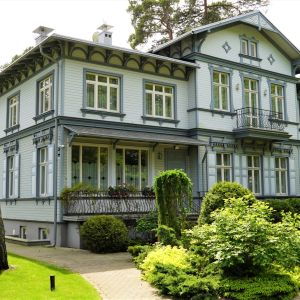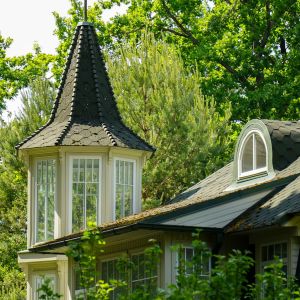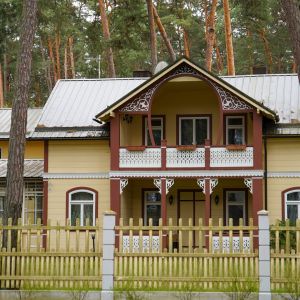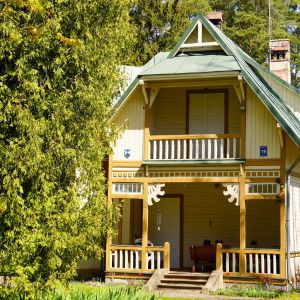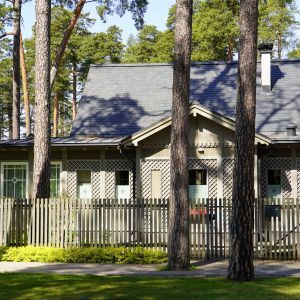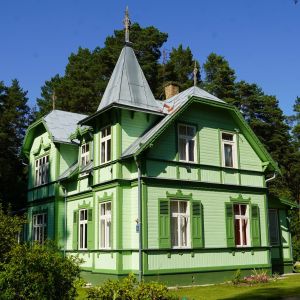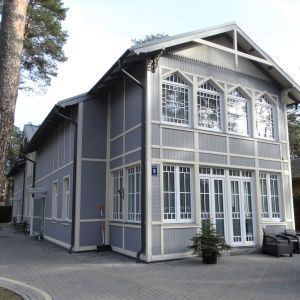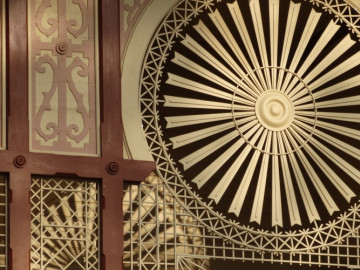The Dzintari Route
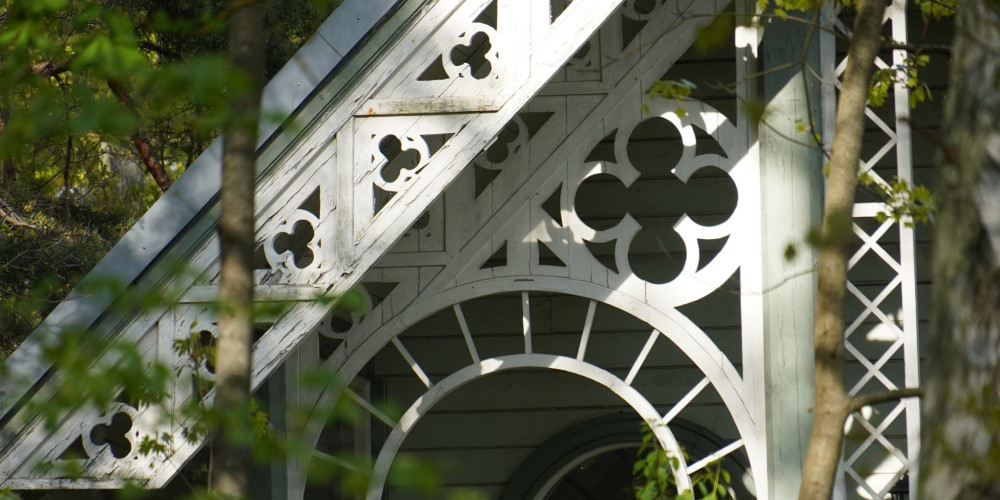
The route leads through the historic Dzintari neighbourhood, also known in earlier times as “Edinburga”, which developed into a prestigious area of summer villas, featuring representative wooden architecture. The buildings along this route – mostly villas and family summer residences built at the turn of the 19th and 20th centuries – are characterised by classical architectural forms enriched with refined National Romantic details.
Route along Dzintaru Prospect:
Starting point – Dzintari Concert Hall (Turaidas Street 1) → Dzintaru Prospect 74 → 58 → 53 → 52/54 (Morbergs’ Villa) → 49 → 41 → 14
Route along Edinburgas Prospect:
Starting point – Dzintari Concert Hall, heading towards Piestātnes Street 19a and 19 → Edinburgas Prospect 35 → 47 → Krišjāņa Barona Street 13 → Edinburgas Prospect 65 → Aglonas Street 2 → 1
Photos: Jūrmala Cultural Space and Environmental Design Centre
Dzintari Concert Hall, Turaidas Street 1
Style: A synthesis of National Romanticism and vernacular architecture, Functionalism, 20th-century architecture
Volume composition:
- Wooden concert hall (1930s)
- Functionalist open-air stage (1960s)
- Glazed concert space and reconstruction (21st century)
Look closer: Dzintari Concert Hall unites three architectural eras and spatial concepts. The original 1936 wooden hall, with interiors by one of Latvia’s most versatile artists Ansis Cīrulis, embodies National Romanticism. In 1960, a modernist-style open-air stage was added, and in 2015 the complex was expanded with a contemporary glass structure.
Construction period: 1936 (Architects: Aleksandrs Birzenieks, Viktors Mellenbergs; Interior – Ansis Cīrulis);
1960 (Architect: Modris Ģelzis);
2015 (Architects: Mārtiņš Jaunromāns, Māra Ābele)
Heritage status: National architectural monument
Dzintaru Prospect 41
Style: Rare example of traditional Jūrmala fishermen’s house typology
Volume composition:
- Asymmetrical volume
- Single-storey log structure
- Roof extension
- Veranda
- Open porch
- Summer kitchen annex
- Utility building with summer kitchen
Look closer: Originally built as a fisherman’s house, this building was later adapted — both visually and functionally — to suit the needs of summer residents, while preserving its authentic character. The delicately latticed veranda adds lightness, while the open porch is adorned with diagonal slat patterns — one of the oldest techniques used to decorate open openings. The restrained façade, painted with traditional linseed oil colours, is enlivened by this finely crafted wooden latticework as a striking visual accent.
Construction period: Late 19th century; reconstructed in 2023 (Architects: Liene Griezīte, Aiga Rozentāle-Baiža)
Heritage status: National cultural monument
Dzintaru Prospect 49
Style: Art Nouveau
Volume composition:
- Symmetrical volume
- Single-storey wooden building
- Verandas
- Balcony
Look closer: A classic example of Jūrmala’s Art Nouveau architecture, with pronounced symmetry on the main façade. The single-storey volume is complemented by a mezzanine and a tower-like extension, while ornate woodcarved decorations and verandas enhance the façade.
Construction period: Early 20th century
Heritage status: National cultural monument
Dzintaru Prospect 52/54, Morbergs’ Villa
Style: Neo-Gothic
Volume composition:
- Asymmetrical volume
- Two-storey timber-frame structure
- Cylindrical tower (belvedere)
- Additional towers
- Veranda
- Open veranda
- Orangery
- Gallery extension
Look closer: This villa ensemble — comprising a winter garden, wine cellar, utility house, and housing for the caretaker and staff — was built by the prominent Latvian builder Kristaps Morbergs. The wooden villa evokes the impression of a feudal castle, featuring Neo-Gothic dentils, vertical accents in the form of corner towers, and arched windows. The façade is clad in copper sheets, and some window openings retain what is believed to be the oldest plate glass in Latvia. The walls were insulated using an innovative method for its time — a layer of pine needles.
Construction period: 1880–1883; restored in 2008 (Architect: Pēteris Blūms)
Heritage status: National architectural and cultural monument
Dzintaru Prospect 53
Style: National Romanticism influenced by Art Nouveau
Volume composition:
- Asymmetrical volume
- Single-storey wooden building
- Mezzanine
- Veranda
- Loggia
Look closer: This residence, designed by architect Wilhelm Bockslaff, is an early 20th-century example of wooden architecture shaped by Art Nouveau influence. It blends vernacular and modernist elements in both form and detail. The low-pitched, hipped roof echoes thatched roof silhouettes; the loggia, veranda panel in herringbone pattern, and chamfered edges of open openings reference ethnographic motifs. The multi-pane window divisions at the top are characteristic of National Romanticism. Set back from the street, the building features a massive yet harmoniously proportioned volume enriched with roof extensions, loggia, and verandas. Utility buildings — including a carriage house, horse stable, and servant quarters — are located at the rear.
Construction period: 1909 (Architects: Wilhelm Bockslaff, Edgars Frīzendorfs)
Heritage status: National architectural monument
Dzintaru Prospect 58
Style: Art Nouveau
Volume composition:
- Asymmetrical volume
- Single-storey wooden building
- Loggias
- Veranda
- Mezzanine
Look closer: The richly decorated façade is marked by a central risalit with openwork loggias and a graceful semicircular arch. The refined impression is further enhanced by decorative carved brackets.
Construction period: Turn of the 19th/20th century; reconstruction in 2024 (Architect: Atis Bīviņš)
Heritage status: Local cultural monument
Dzintaru Prospect 74, lit. 3
Style: Historicism
Volume composition:
- Asymmetrical volume
- Single-storey wooden building with plinth floor
- Polygonal tower
- Verandas
Look closer: The asymmetrical composition is highlighted by distinct veranda solutions, giving the house an individual character. A reconstruction in 2000 preserved its historical silhouette.
Construction period: Early 20th century; reconstructed in 2000
Heritage status: Local architectural monument
Edinburgas Prospect 35, lit. 1
Style: Historicism
Volume composition:
- Asymmetrical volume
- Two-storey wooden building
- Verandas
Look closer: The expressive façade composition features richly carved wooden details, finely divided window frames, and glazed verandas. Carved wooden lacework in semicircular forms unifies the entrance portal and second-floor window openings, emphasizing the building’s vertical articulation.
Construction period: Early 20th century
Heritage status: Local cultural monument
Piestātnes Street 19a
Style: Historicism
Volume composition:
- Asymmetrical volume
- Single-storey wooden building
- Mezzanine
- Verandas
Look closer: This wooden summer house features an artistically crafted mezzanine with a loggia and a covered porch. The openings are decorated with intricate woodcarvings and lattice motifs.
Construction period: Early 20th century
Heritage status: Regional cultural monument
Piestātnes Street 19
Style: Art Nouveau
Volume composition:
- Asymmetrical volume
- Single-storey wooden building
- Mezzanine
- Loggias
- Corner extension
- Summer kitchen annex
Look closer: This charming building captivates with its authentic details — handcrafted by local artisans from native wood over a century ago — and retains a natural, unpretentious character.
Construction period: Early 20th century; restored in 2023 (Architects: Ingrīda Sarguna, Iveta Plato, Dace Rozenberga)
Heritage status: National cultural monument
Edinburgas Prospect 47
Style: Traditional Jūrmala wooden villa typology
Volume composition:
- Symmetrical volume
- Single-storey wooden building
- Verandas
Look closer: The villa features symmetrical glazed verandas at both ends, creating a balanced silhouette. The richly carved roof overhang adds a decorative flourish to the composition.
Construction period: 1920
Heritage status: Regional architectural monument
Edinburgas Prospect 65
Style: Art Nouveau
Volume composition:
- Asymmetrical volume
- Single-storey wooden building
- Verandas
- Terrace
- Balcony
Look closer: The prominent corner element and variety of architectural features — verandas, terrace, balcony — lend the building spatial dynamism. The roof structure dominates the overall composition, while the façade incorporates both Art Nouveau and National Romantic elements.
Construction period: 1909
Heritage status: Local cultural monument
Aglonas Street 2
Style: Art Nouveau
Volume composition:
- Asymmetrical volume
- Single-storey wooden building
- Rectangular tower
- Verandas
Look closer: A characteristic example of wooden Art Nouveau, with a picturesque corner tower defining the silhouette. The glazed verandas introduce rhythm and transparency, integrating the building harmoniously into its surrounding landscape.
Construction period: Early 20th century; reconstructed in 2007
Heritage status: Local cultural monument
Aglonas Street 1
Style: Art Nouveau
Volume composition:
- Asymmetrical volume
- Single-storey wooden building
- Mezzanine
- Plinth floor
- Square tower
- Verandas
Look closer: The building is distinguished by its abundant woodcarvings, including window cornices and finely patterned horizontal bands. The vertical ornamentation on the tower spire serves as a visual focal point, harmonizing with the surrounding pine landscape and giving the house a vivid, painterly character.
Construction period: 1910; restoration in 2024 (Architect: Valda Vaskinoviča)
Heritage status: Local cultural monument
Krišjāņa Barona Street 13
Style: Art Nouveau
Volume composition:
- Asymmetrical volume
- Two-storey wooden building
- Mezzanine
- Three-storey rectangular tower
Look closer: The building’s architectural expressiveness is defined by the three-storey tower on the southeast corner, adding a vertical emphasis to the composition. The façade details — including carved window openings and silhouette-cut ornamentation — create a refined and decorative overall impression influenced by Art Nouveau.
Construction period: Early 20th century; restored in 2017
Heritage status: Local cultural monument

